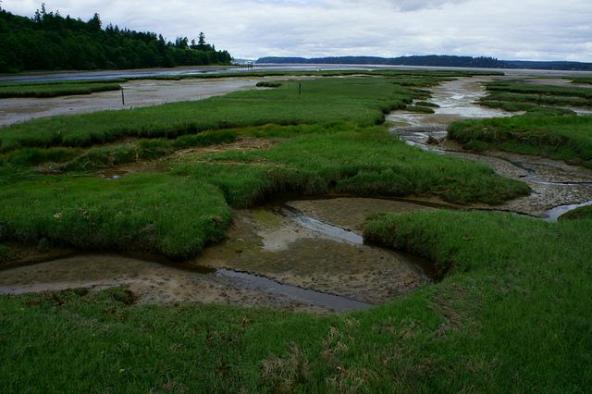Types of estuaries in Puget Sound
An estuary is a place where saltwater from the ocean mixes with freshwater from rivers and streams. Technically, this defines all of Puget Sound, but scientists have identified several types of "sub-estuaries" within the water body. These include pocket estuaries (or embayments), tidally-influenced rivers and wetlands and other areas near the shoreline connected with freshwater sources. This summary provides descriptions of these estuaries from the Washington State Department of Natural Resources, the Puget Sound Nearshore Partnership and others.
Overview: The estuarine system within Puget Sound
The Estuarine System generally consists of waters that are semi-enclosed by land but have open, partly obstructed, or sporadic access to the ocean, and in which seawater is at least occasionally diluted by freshwater runoff from land. It extends upstream and landward to where ocean-derived salts near the water surface measure ~0.5 parts per thousand (ppt) during the period of average annual low flow, and downstream or out to sea to where freshwater dilution is minimal (salinities seldom falling below 30 ppt). The Estuarine System thus includes classic river-mouth estuaries, lagoons, and large bodies of water such as Puget Sound and the Strait of Georgia which are signficantly diluted by freshwater input from numerous sources.
_____________________________________________________________________________________________________________________
Estuarine classifications
Portions of the following text are taken from “A Geomorphic Classification of Puget Sound Nearshore Landforms” by Hugh Shipman, prepared in support of the Puget Sound Nearshore Partnership.
Pocket estuaries, or embayments
Embayments: This term describes protected estuaries and lagoons within which there is too little wave action to form beaches. The term pocket estuary has been widely used in Puget Sound to describe these features. Most of these small embayments are tidally influenced, but they also include isolated lagoons and wetlands. Estuaries are those with a significant input of freshwater – for example, from a surface stream, whereas lagoons have limited freshwater input. A large number of the estuaries and lagoons on Puget Sound are formed and enclosed by barrier beaches, emphasizing an important geomorphological relationship between the wave-dominated beach environments and these small protected estuarine environments.
Large river deltas
Large river deltas: This category is reserved for the deltas of the large rivers that drain the Cascade and Olympic mountains. These deltas, built of fluvial sediment deposited at the coastline, are often broad and low-lying, and represent the marine extension of alluvial floodplains. Many have been heavily modified for agricultural and urban uses. Deltas can be distinguished based on the rela-tive influence of waves, tides and river processes in their formation. Deltas are associated with streams of all sizes, but smaller ones are generally subsumed within the other systems – for example, stream deltas can occur within the upper reach of a small estuary or directly on an exposed beach.
See also: The mosaic of deltas and other estuarine ecosystems in Puget Sound.
The broader estuarine complex
General mixing throughout the system: The Puget Sound basin is connected to the Strait of Juan de Fuca and the Strait of Georgia as part of the broader Salish Sea. The entirety of this region can be described as an estuarine complex with variations in freshwater mixing throughout. In some cases this mixing varies according to nearshore features such as beaches or rocky shorelines. Because estuarine waters are often connected and boundaries may be fluid, additional categorizations of some estuaries may occur in more detail than we have described here. Estuarine waters can also vary by season. Surface waters through the Strait of Juan de Fuca technically vary seasonally between estuarine and marine, relative to "polyhaline" salinities 18-30 ppt/psu (Ebbesmeyer et al. 1988).
Citations:
Ebbesmeyer, C. C., J. Q. Word, and C. A. Barnes (1988): Puget Sound: a fjord system homogenized with water recycled over sills by tidal mixing. Hydrodynamics of Estuaries: II Estuarine Case Studies, B. Kjerfve, Ed., CRC Press, 17-30.
_____________________________________________________________________________________________________________________
Additional resources
Puget Sound: A uniquely diverse and productive estuary
The mosaic of deltas and other estuarine ecosystems in Puget Sound






